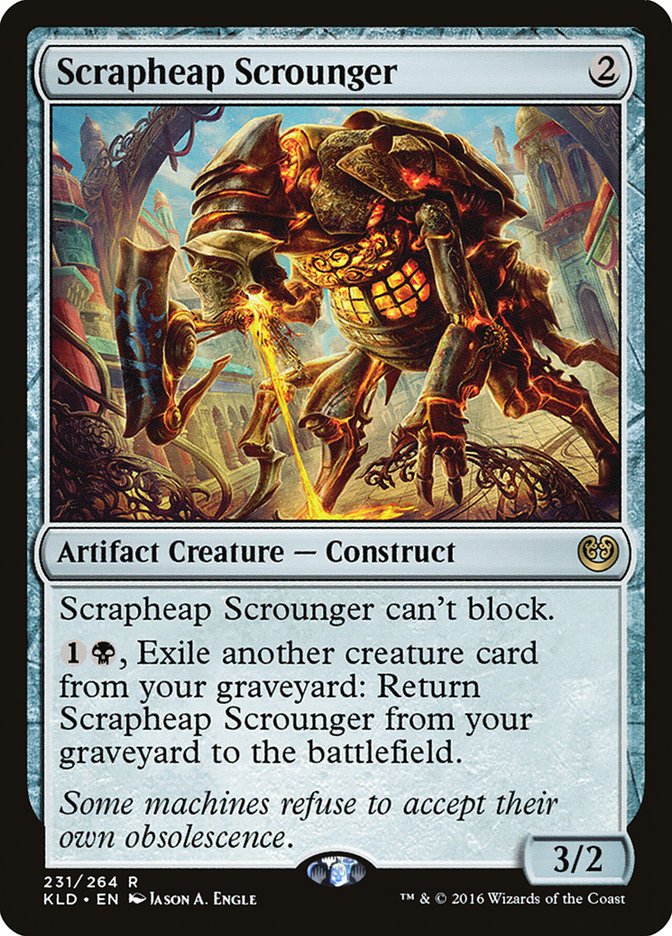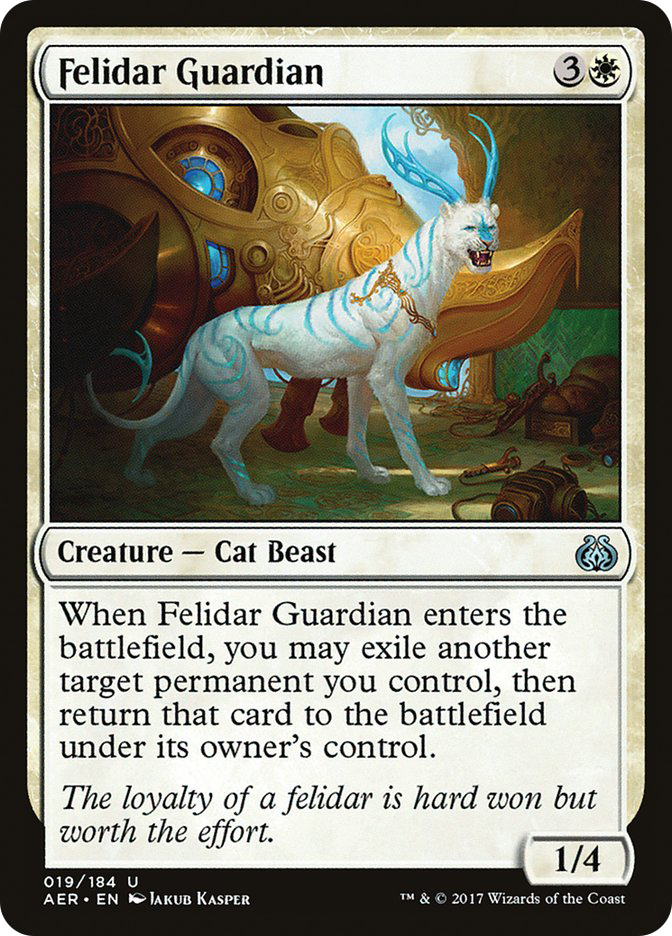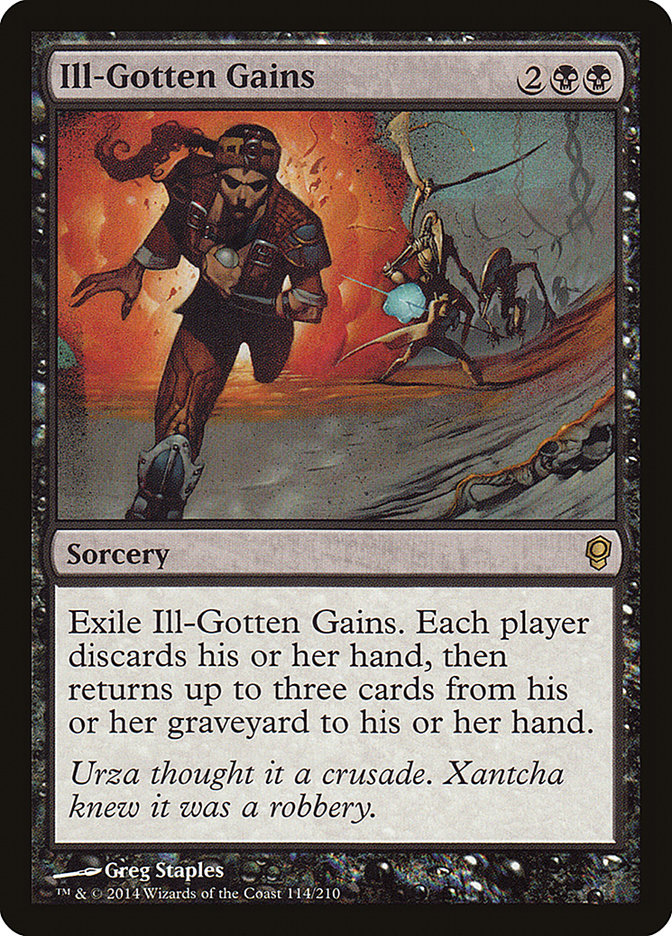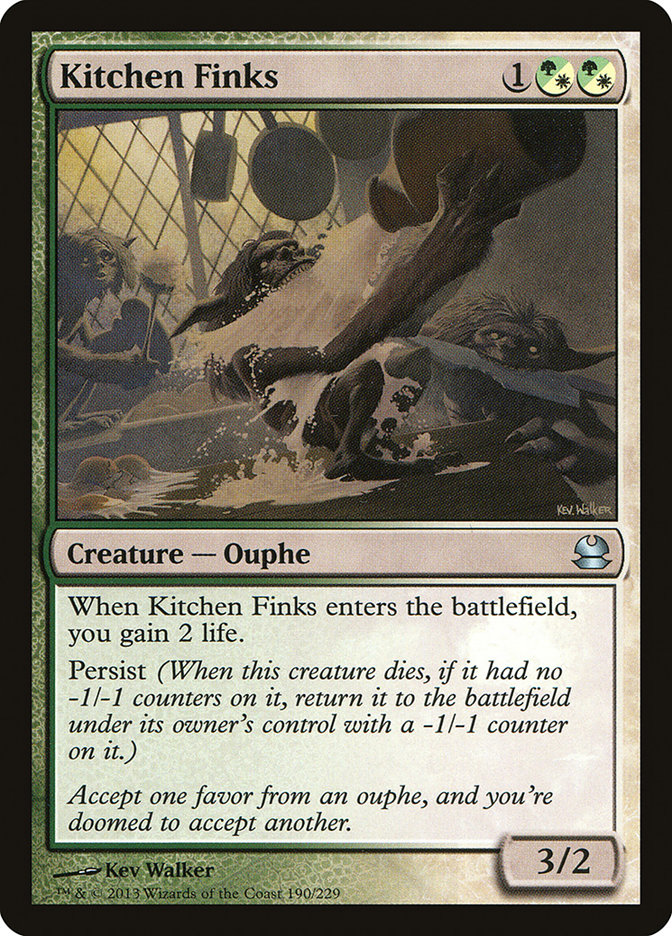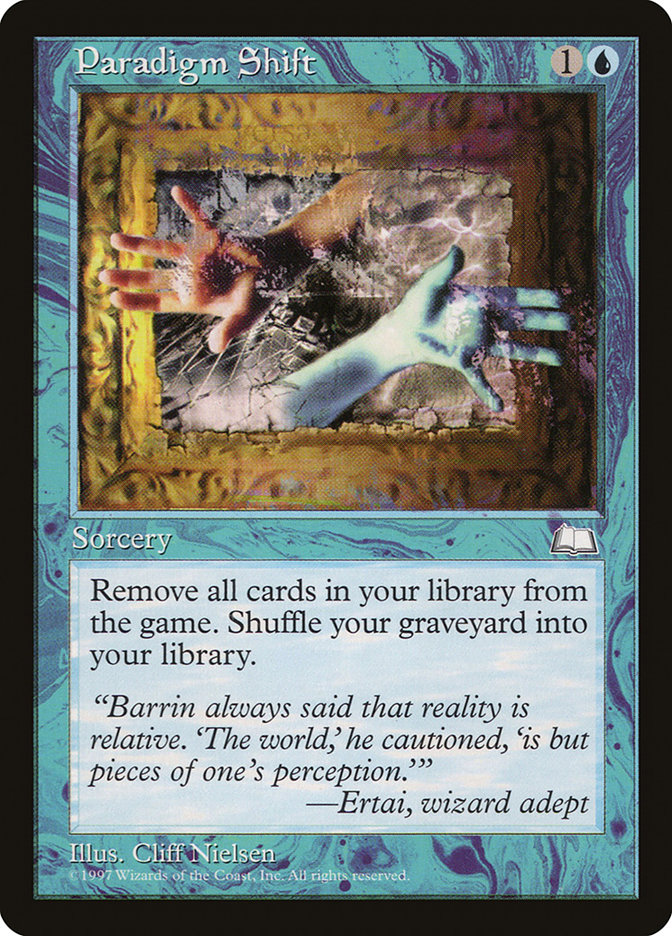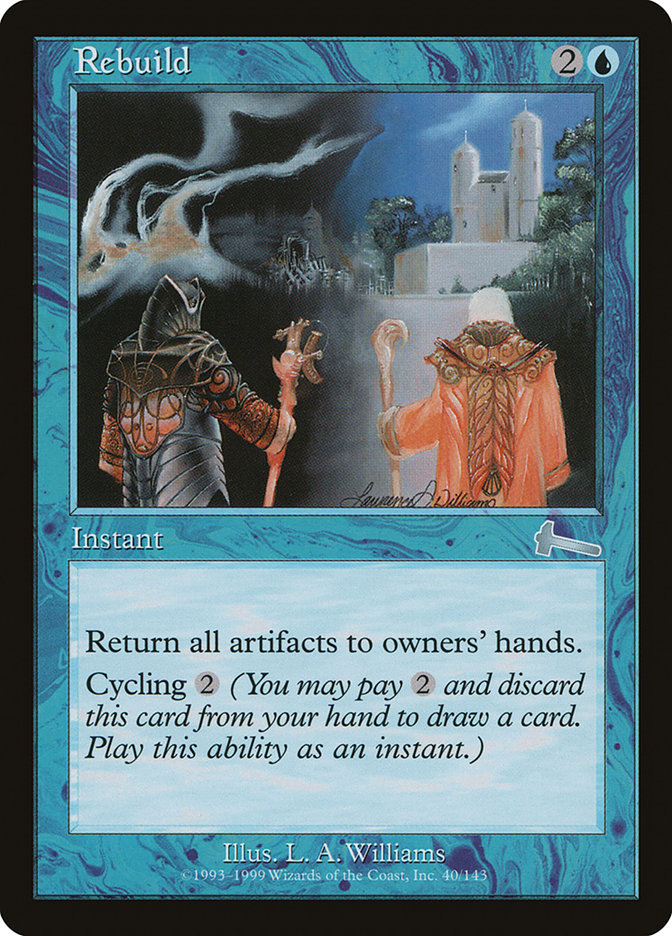No changes.
Felidar Guardian; Gideon, Ally of Zendikar; Heart of Kiran; Scrapheap Scrounger; Walking Ballista; and every other Standard card that you may or may not love and/or hate are going to stay around for at least a little while longer.
Reaction to the non-ban has been… less than positive, with many players disappointed at Wizards of the Coast’s unwillingness to take action to change a stale format. Amonkhet brings renewed hope at combating the top decks, but in a shocking reversal from previous preview seasons, weeks of overhyping have been replaced with repeated cynicism over whether or not the new cards can compete with the power of Gideon, Ally of Zendikar and a turn 4 combo.
Personally, I would’ve banned Felidar Guardian. I’m confident in the belief that its interaction with Saheeli Rai was completely missed during design and development, and as a result its effect on the metagame is unchecked, even in later sets, due to the lag between development and release. A two-card combo where the pieces are reasonable cards by themselves is very difficult to stop, as they can be placed into a shell with a strong backup plan that is aided by the threat of the combo. This last Standard season was no exception, as Four-Color Saheeli rose to prominence quickly after the Pro Tour and only the sheer power of Gideon, Ally of Zendikar; Heart of Kiran; and Aetherworks Marvel has been able to compete with it on a regular basis.
The threat of the combo invalidates a large number of strategies, essentially any deck building toward large tapout threats that isn’t specially equipped to handle the combo. Ishkanah, Grafwidow was the major loser here, as it could only be defended by removal on Felidar Guardian, which wasn’t enough. So, in order to increase format health and diversity, I would’ve banned the combo.
But here’s the thing: I’m always going to be more concerned with format health than any of the other factors that go into banning cards, most notably consumer confidence.
Yes, I play Magic. A lot. And I buy a fair amount of cards. But for me those cards are just tools of the trade, like sneakers for an athlete or a lathe for the woodworker. I’m already prepared to switch decks often and don’t care as much if I lose value on the previous deck.
Simply put, I’m not a consumer in the same way Timmy at FNM is. Timmy saves his allowance every week and trades at his store to build his decks, and that process can takes weeks and months. With all that work put in, he wants to be able to play with the finished product for a while in order for his efforts to be worthwhile.
And those issues aren’t just relegated to the younger crowd at stores. Magic is a hobby for most people and as a result is a sink for precious disposable income. No one wants to see that income go to waste.
If you read Jim Davis’s reactiontothebansyesterday, you see that that these players are in an awkward position of both disliking the current format and disliking the prospect of a second wave of bans further eroding consumer confidence. I don’t play as often as Jim does at local stores, due to his spellslinging with Metagame Gurus, so I’ll trust his read of the reaction from local-level Magic communities to the previous Standard format and the impending ban announcement. I’ll also agree with Jim that this is a very difficult decision for WotC to make, especially when everyone has an opinion on it either way.
Some think format health is the more important variable; others think it’s consumer confidence. I noted above that personally I place more value on format health due to my relationship with Magic, but more importantly I think framing the question in this way sidesteps the bigger issue.
Magic is a huge game with a diverse player base. As a result, we have many communities at very different levels that are looking for very different things.
First, there are the kitchen table players. They play very casually with their friends and largely govern themselves. Many of them may not be aware of competitive metagames, banned lists, or even different Constructed formats like Standard or Modern. Thus this group is almost entirely ambivalent toward bans. That was easy.
The second group is the casual store players. They play FNM regularly, maybe some Game Days, and the occasional competitive event like a PPTQ or local Open. They play competitive formats, but a big chunk of them won’t play the top-tier decks because they find the game more fun when they can be creative, even if they don’t win as often. There’s a competitive attitude to these players, but they don’t take Magic too seriously. They care about both sides of the ban issue but tend to favor format health and diversity because oppressive decks make it harder for their brews to succeed.
The next step up on the ladder is the competitive local player. They test on MTGO, at FNM, or both and they play every local PPTQ, Open, and GP that they can. They have a test group and they want to make it to the next level. You might think that this group cares more about format health, but in reality they care more about winning than the games being interesting, and if playing a broken deck helps them win, then so be it. Consumer confidence is also an issue for these players because they are often playing on a budget and switching decks is costly.
And finally we come to the entrenched competitive players. Some are full-time professionals, others part-time. As part of this group, I’m most confident generalizing here, and as I’ve noted, I (and thus we) are mostly unaffected financially by bans, so we care much more about format health than anything else. Professional Magic is a grind and playing against the same two to three decks for months straight is trying, whereas resleeving a new deck is pretty easy.
Now, it’s important to see this is a very rough sketch of the Magic community, and many players either buck the trend from their group or span multiple groups. There are also plenty of Magic players who are aware of the conflicting interests that exist and take the time to weigh those interests against each other and arrive at a conclusion that they think is best for the game as a whole. My sketch is not meant to capture those opinions, instead focusing on what these players would prefer when disregarding the desires of the rest of the community.
The result is a community that is irrevocably divided by the issue of bans. The arguments that swirl around announcement time always hinge on which issue is most prevalent in a given instance, but that doesn’t address the structural issue that exists: the way organized play in Magic is structured creates the opposition in the first place.
There may be some overlap, but for the most part regular FNMers and regular Pro Tour players interact with Magic completely differently. The ways they approach deckbuilding, gameplay, and tournament preparation are all different. It’s a testament to how good a game Magic is that it can attract such a wide array of people, but it’s a failure of organized play that they exist under the same umbrella.
Sure, FNM and the Pro Tour operate under different Rules Enforcement Levels, and for good reason. But that’s not enough. These are the same game the way pick-up basketball and the NBA are the same game, which is to say they aren’t. That statement should in no way be taken as a denigration of non-pro players. Most of them aren’t trying to play the same game in the same way that we do. Even if they follow high-level tournaments and read content, they are going to want to add their own spin to the default best decks and strategies, and that’s great.
So why are we governed by the same body and in the same way?
We’ve already seen this issue arise before with the Modern Pro Tour. Part of the draw to Modern was to have your deck stay relevant for long periods of time and bans undermined that too often. But the format needed to be shaken up for Pro Tours in order to create a healthy format for the premier event. The conflict was resolved by replacing the Modern Pro Tour with a Standard one, but now we’ve seen the same issue occur with Standard and there’s no format left to run to.
Even if Amonkhet creates a balanced format, this issue will arise again. Designing Magic cards is a difficult job and more mistakes will be made. We need to look for more radical, permanent solutions instead of band-aids.
Consider a world where the Banned List was only in effect for competitive REL events and on MTGO. The exact details aren’t particularly important to this article and can be left open for debate. They key is in formally separating groups of Magic players that largely interact with the game in very different ways.
In this world, cards can be banned more aggressively for high-level events, creating more dynamic metagames and making the tournaments more interesting for viewers. Players who are playing Standard under no Banned List can still take the pros’ ideas and adapt them for their own environment. The decks may not be ideal, but they don’t have to be. These players don’t want the absolute best deck; they want something interesting and fun that’s above a certain baseline of competitiveness.
But there’s still a glaring issue here. FNM attendees are often the most vocal about oppressive decks making their tournaments unfun. We have to have a mechanism to alleviate this issue without running afoul of their consumer confidence concerns.
The solution here, to me, appears rather simple: Let local communities police themselves. Standard still only allows the most recent sets, but local stores can decide on their own Banned Lists by whatever metrics they wish. Local communities care about fun, and aren’t they best-equipped to decide what they find most fun?
This solution certainly leads to some issues. Are viewers going to tune out from major events if the format is too far removed from what they play? Perhaps, but the draws to watching Magic go past searching for the next great tech. Viewers want to see two great players battle and they want to follow their favorite players. Those draws for viewers aren’t affected at all. And as I mentioned earlier, they can still adapt top decks for their local metagames in many cases.
How does this change affect local communities? Are neighboring stores going to collaborate to offer different formats for players to explore? That idea sounds exciting to me, and it’s not particularly difficult to implement.
There could be problems for players in more remote areas with few stores or even one local store within a reasonable distance. If their store creates a format they don’t want, they don’t have the option to go to another. But currently that’s true of every person who doesn’t like Standard because of Felidar Guardian and the like. This change only opens up more chances for a player to enjoy the formats offered.
Awkwardness could arise with players who are unaware of a given store’s Banned List, especially if they’re in an unfamiliar area, but given the relative rarity of bans and the speed at which we can spread information in 2017, I don’t see this being a significant problem, and one that will diminish over time as players adapt to the new world order.
The biggest downside I can see is for Magic content. We’re generally writing about competitive Magic, and the disconnect could make more casual players disinterested in our deck techs, sideboard guides, and new brews. But again, the differences here are not insurmountable. Players can take important lessons away from articles and videos and apply them to their specific situation.
Moreover, having localized Banned Lists could create added demand for content producers willing to cater to commonly used Banned Lists in the same way that player-driven formats like Cube, Commander, and Frontier have gained prominence over the years.
I would also be worried about how this changes the effects of bans on the secondary market. Will most stores simply follow the Competitive Banned List for simplicity’s sake, thus creating little, if any, change? If banned cards plummet in price regardless of individual FNMs allowing them, will players who bought them still feel slighted or will they be happy that they can still play with them? I’m assuming the latter, although some portion of them may still be locked out by their local communities, so even in the most optimistic scenario the problem isn’t completely solved.
This is far from the only solution for the problem, and it’s not a perfect one. The only thing I’m certain of is that regulating professional players and casual-competitive players with the same pen is a structural problem in Magic right now, and Banned List issues are a symptom of that issue rather than a problem in and of themselves.
The strongest solution likely entails a complete restructuring of professional Magic and Organized Play, which is unlikely to occur any time soon. I’ll end by urging that we not disregard radical solutions. Professional Magic started over twenty years ago with a much smaller community and when the internet was in its infancy.
The world we live in today is much different, and Magic as a game has changed in significant ways. We have new mulligan rules, a stack system to make casting spells more intuitive, and damage no longer goes on the stack. But as the game changed, the tournaments stayed mostly the same. There are Pro Tours and Grand Prix that give out Pro Points. They have Swiss rounds followed by a cut to Top 8. The former are invitation-only and the latter are open to all.
What are the odds that we have all those things right?
We writers often encourage you readers to look for systemic issues with your gameplay. Rather than looking at each mistake in a vacuum, try to find the pattern and correct that pattern moving forward, whether it’s failure of role assessment or tunnel-visioning too often.
To ban Felidar Guardian or not is only the surface of the problem. Look deeper.


